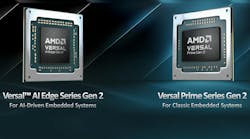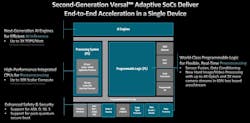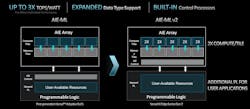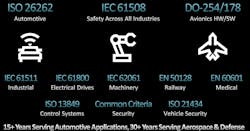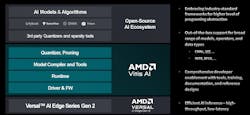Adaptive SoC Delivers Single-Chip Automotive Solution
What you’ll learn:
- How AMD’s Versal Gen 2 delivers a 10X performance boost.
- Why safety-certified FPGA SoCs are needed for automotive applications.
- What types of artificial-intelligence acceleration are provided by Versal Gen 2?
Versal Gen 2’s safety certification is a key enhancement of the newest Adaptive Compute Acceleration Platform (ACAP) from AMD. It uses the same general architecture as the current generation, but it delivers significantly more performance and capability (Fig. 1). ACAP combines hard logic such as artificial-intelligence (AI) engines and Arm Cortex cores with FPGA programmable logic. These chips can address a range of applications, including automotive advanced driver-assistance systems (ADAS) that require safety certification levels such as ASIL D and SIL 3.
One notable aspect of the new generation is the inclusion of more hard logic than before. This is especially true for image and video encode and decode to handle data that’s commonly processed using such a platform. The family can support ultra-high-definition (UHD) video streaming and recording applications including multichannel, 8K video streams in real-time.
There’s also support for high-speed, 100-Gb Ethernet needed to move data in and out of the chip. It handles PCIe Gen 5 that enables support for the latest Compute Express Link 2.0 (CXL), including CXL-attached memory.
The hard-core compute infrastructure leverages the latest Arm Cortex-A78AE application processors (x8) and Cortex-R52 real-time processors (x10). These give a performance boost by a factor of ten compared to the previous generation. It also turns the chips into significant compute platforms even without the additional acceleration units and programmable logic.
Cores can be configured for lockstep support, which is often required for safety-critical applications such as automotive electronic control units (ECUs). The Arm Mali-G78AE GPU provides additional computation and display capabilities.
Security is addressed from the start with this incarnation of Versal. Its secure boot employs post-quantum cryptography. This means using newer encryption algorithms that are resistant to attacks by algorithms running on quantum computers. The chips can be certified for automotive security standards like ISO 21434.
Introducing AMD Versal Gen 2: Advances in Performance and AI
The artificial-intelligence engines (AIEs) in Gen 2 deliver twice the performance capabilities and move control logic from the FPGA fabric into hard logic (Fig. 2). Many of the AIE control processors have been moved to more efficient hard logic. The programmable logic still incorporates AI support, plus it allows for access to the AIEs to handle AI/ML-related datatypes like INT8.
Many AI applications can take advantage of the additional hard logic when it comes to image and video processing. Combined, Gen 2 provides 4X the image processing power and 2X the video processing power, as well as 3X better TOPS/W than Gen 1. The chips are also smaller with better power utilization.
The new hardware manages a greater number of data types. Gen 1 had support for standard floating point and integers. Gen 2 adds support for MX6 and MX9 shared exponent data types. AI inference performance can be increased using multiple device densities as well as sparse arrays.
As noted earlier, safety certification is required for many applications, which Gen 2 is designed to address (Fig. 3). Long-term support is also part of the latest announcement—a critical feature for many of the safety applications targeted by these ACAP solutions.
Software support is key to the success of the Versal platform (Fig. 4). AMD’s Vivado toolset targets the chip’s programmable logic while software development centers around the Vitis Unified Software Platform. Vitis lets developers take advantage of the FPGA without programming it directly by utilizing PL configurations from third parties and other sources, including logic from AMD libraries.
One company already employing Versal in the automotive space is Subaru. Its EyeSight ADAS vision system uses three cameras to provide features like adaptive cruise control, lane departure warnings, automatic emergency steering, and pre-collision braking and throttle management.
In many cases, a single Versal AI Gen 2 chip can handle all of the computing needs for an application. The software tools are available now; chips and evaluation kits will be available in 2025. The Gen 2 family includes the Versal AI Edge Series Gen 2 and Versal Prime Series Gen 2, with the former incorporating the enhanced AI support.
Check out more of our coverage of embedded world 2024.
